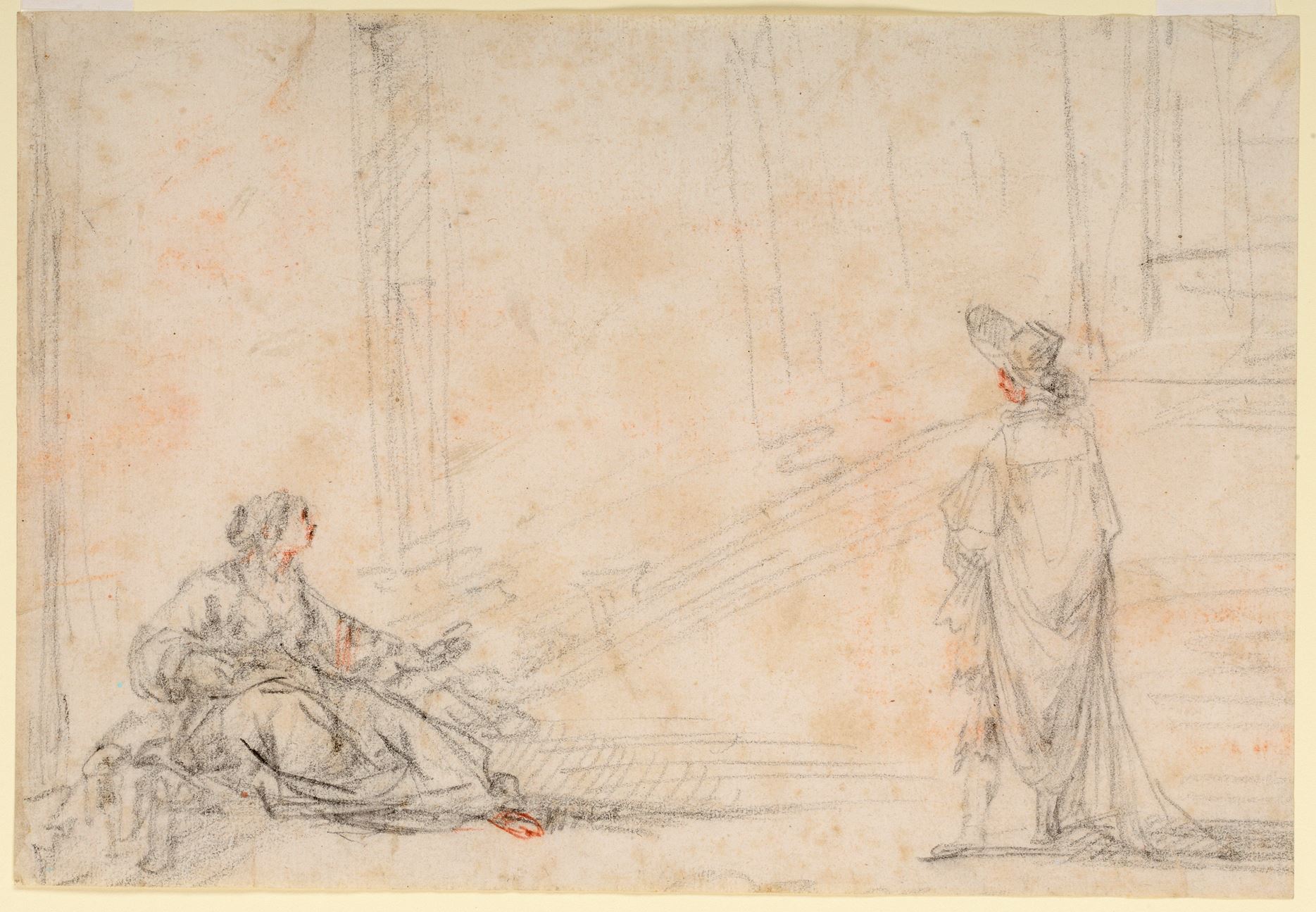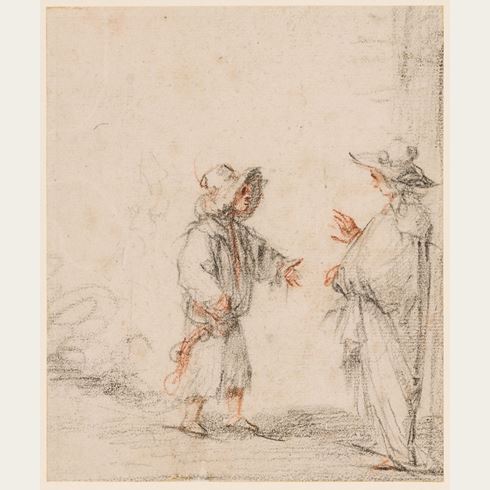Francesco Montelatici CECCO BRAVO
(Florence 1601 - Innsbruck 1661)
A Dream: A Male Figure Appearing to a Seated Woman
Sold
Red and black chalk.
187 x 274 mm. (7 3/8 x 10 3/4 in.)
187 x 274 mm. (7 3/8 x 10 3/4 in.)
This is a splendid example of Cecco Bravo’s distinctive manner of drawing, characterized by the use of a combination of red and black chalk and a feathery, seemingly insubstantial depiction of form; an idiosyncratic technique that, in the words of one scholar, ‘challenged the rigor of Florentine disegno in its fine disregard for contour.’ On stylistic grounds, it may be tentatively added to a small group of drawings by Cecco Bravo, all executed in red and black chalk, which are known as the ‘Sogni’ (or ‘Dreams’). This enigmatic series of drawings, which number about thirty in total, were first referred to as ‘sogni’ by a previous owner; the Florentine scholar Niccolò Gabburri, who further notes that they had originally belonged to Filippo Baldinucci. As Gabburri writes, in his 1739 biography of Cecco Bravo, ‘Nella collezione del celebre Filippo Baldinucci scrittore delle vite dei Pittori, si ritrovano giá circa 30 disegni istoriati, a lapis rosso e nero, nei quali erano espressi vari sogni del medesimo Cecco Bravo, cosa, a dir vero, molto singolare, che fa vedere non tanto la stravaganza di quell’ umore bizzarro, quanto eziandio, il brio e l’intelligenza di quel grand’uomo.’
The precise subjects of these ‘Dream’ drawings - thought to date from relatively late in Cecco Bravo’s career - have long resisted identification, though Gabburri suggests that they were representations of the artist’s own nighttime visions. (The contemporary writer Giovanni Cinelli described Cecco Bravo as a man ‘of melancholy demeanour who, like all hypochondriacs, was wont to speak of the dreams he had at night as if they were the truest things that had come to pass.’) While some religious symbolism is found in several of these ‘Dream’ drawings, they do not appear to illustrate any known ecclesiastical or literary narrative, and may simply be a product of the artist’s melancholic imagination, and done for his own pleasure. Nevertheless, as Julian Brooks has noted, ‘While it is tempting to believe that these sheets simply represent dreams had by the artist, their quantity, substantial sizes and finish suggest that they more likely relate to a large-scale, almost public, exposition of a theme.’
After passing though the collections of both Filippo Baldinucci (1625-1696) and Niccolò Gabburri (1675-1742), Cecco Bravo’s ‘Dreams’ – almost certainly bound into an album with many other drawings - were acquired from Gabburri’s heirs by the English art dealer William Kent. The album was broken up and the drawings seem to have been dispersed in London in the middle of the 18th century; indeed all of the extant ‘Dream’ drawings have later English provenances. For example, between twelve and eighteen of these drawings by Cecco Bravo were included in the sale of the collection of the 18th century portrait painter George Knapton in London in May 1807, where they were identified simply as ‘large dreams’ or ‘a midnight dream, &c.’ and described as ‘very fantastical’, ‘elegant’ and ‘pleasing compositions’. As the Knapton sale catalogue described the author of these drawings: ‘He was an Artist of very prolific genius in the representation of fantastic subjects, which by the Amateurs, are called his Dreams: they are usually executed in red and black chalk, with infinite spirit, and certainly possess great merit.’
Of the thirty or so drawings from this group of ‘Dreams’ by Cecco Bravo that once belonged to Baldinucci and Gabburri, only a handful are known today, almost all of which are in museums. A total of eleven drawings from this series of ‘Dream’ drawings are today divided between the collections of the British Museum, the Ashmolean Museum in Oxford, the National Gallery of Scotland in Edinburgh, the Louvre, the Art Institute of Chicago, the Pierpont Morgan Library in New York, the Statens Museum for Kunst in Copenhagen and the J. F. Willumsen Museum in Frederikssund, Denmark.
A black and red chalk study of a man wearing a similar wide-brimmed hat, albeit standing in reverse, was sold at auction in London in 1972.
The precise subjects of these ‘Dream’ drawings - thought to date from relatively late in Cecco Bravo’s career - have long resisted identification, though Gabburri suggests that they were representations of the artist’s own nighttime visions. (The contemporary writer Giovanni Cinelli described Cecco Bravo as a man ‘of melancholy demeanour who, like all hypochondriacs, was wont to speak of the dreams he had at night as if they were the truest things that had come to pass.’) While some religious symbolism is found in several of these ‘Dream’ drawings, they do not appear to illustrate any known ecclesiastical or literary narrative, and may simply be a product of the artist’s melancholic imagination, and done for his own pleasure. Nevertheless, as Julian Brooks has noted, ‘While it is tempting to believe that these sheets simply represent dreams had by the artist, their quantity, substantial sizes and finish suggest that they more likely relate to a large-scale, almost public, exposition of a theme.’
After passing though the collections of both Filippo Baldinucci (1625-1696) and Niccolò Gabburri (1675-1742), Cecco Bravo’s ‘Dreams’ – almost certainly bound into an album with many other drawings - were acquired from Gabburri’s heirs by the English art dealer William Kent. The album was broken up and the drawings seem to have been dispersed in London in the middle of the 18th century; indeed all of the extant ‘Dream’ drawings have later English provenances. For example, between twelve and eighteen of these drawings by Cecco Bravo were included in the sale of the collection of the 18th century portrait painter George Knapton in London in May 1807, where they were identified simply as ‘large dreams’ or ‘a midnight dream, &c.’ and described as ‘very fantastical’, ‘elegant’ and ‘pleasing compositions’. As the Knapton sale catalogue described the author of these drawings: ‘He was an Artist of very prolific genius in the representation of fantastic subjects, which by the Amateurs, are called his Dreams: they are usually executed in red and black chalk, with infinite spirit, and certainly possess great merit.’
Of the thirty or so drawings from this group of ‘Dreams’ by Cecco Bravo that once belonged to Baldinucci and Gabburri, only a handful are known today, almost all of which are in museums. A total of eleven drawings from this series of ‘Dream’ drawings are today divided between the collections of the British Museum, the Ashmolean Museum in Oxford, the National Gallery of Scotland in Edinburgh, the Louvre, the Art Institute of Chicago, the Pierpont Morgan Library in New York, the Statens Museum for Kunst in Copenhagen and the J. F. Willumsen Museum in Frederikssund, Denmark.
A black and red chalk study of a man wearing a similar wide-brimmed hat, albeit standing in reverse, was sold at auction in London in 1972.
Little is known of the artistic education of Francesco Montelatici, known as Cecco Bravo, apparently on account of his violent temperament. He receives only a passing mention, as a student of Giovanni Bilivert, in Filippo Baldinucci’s account of 17th century Florentine painting. He is also thought to have been a pupil of Domenico Passignano and Matteo Rosselli, under whose supervision he worked on several fresco cycles in Florence in the 1620s. By 1629 Cecco Bravo had established his own studio in Florence and was admitted into the Accademia del Disegno. Apart from a few months in Emilia Romagna and Venice between 1630 and 1631, he worked in Florence and Tuscany for most of his career. In 1633 he decorated the cloister of the church of Santissima Annunziata in Pistoia with a cycle of lunette frescoes of six scenes from the life of Bonaventura Bonaccorsi. Among his most significant works in Florence were mural frescoes for the Sala degli Argenti in the Palazzo Pitti, painted in the late 1630s, while he also contributed to the decoration of the Casa Buonarroti on the Via Ghibellina. In 1656 Cecco Bravo was appointed master of the life drawing classes at the Accademia di San Luca in Florence. The later years of his career were largely spent painting easel pictures, many of which are recorded in a 1660 inventory of his studio but are now lost. In 1660 he was summoned to work at the court of the Archduke Ferdinand Karl of Austria at Innsbruck, where he died the following year.
Cecco Bravo has only recently been recognized by art historians as one of the most original and distinctive artists of the Florentine Seicento. As Miles Chappell has noted, ‘his paintings, with their deep, at times passionate expression, forceful figures and impetuous definition with a loaded brush, represent almost a painterly inversion of the Florentine tradition of rigorous disegno…a stylistic identity that is at once spirited, elegant and unique in its pictorial dissolution of form.’ He was also a highly original and gifted draughtsman, and the 18th century Florentine collector and art historian Francesco Maria Niccolò Gabburri wrote of his drawings that they ‘are sought and treasured by connoisseurs because they truly possess a spirit and wonderful expression beyond all human understanding.’
Although a fairly large number of drawings by Cecco Bravo survive, only a handful of these may be related to surviving paintings. Among the artist’s drawings are numerous studies of male nudes, saints and religious subjects, as well as a series of mysterious allegorical drawings known as the ‘sogni’ (‘dreams’). Significant groups of drawings by Cecco Bravo are today in the collections of the Uffizi (which houses over 250 sheets) and the Biblioteca Marucelliana in Florence, the Louvre, the Biblioteca Olivieriana in Pesaro, the National Gallery of Scotland in Edinburgh, the Statens Museum for Kunst in Copenhagen, and elsewhere.
Provenance
Probably Filippo Baldinucci, Florence, and by descent to his heirs
Probably acquired from them by Francesco Maria Niccolò Gabburri, Florence
Probably William Kent, London, and sold by him in the early 1760s
The Earls of Crawford and Balcarres, Balcarres House, Colinsburgh, Fife By descent to a private collection.
Probably acquired from them by Francesco Maria Niccolò Gabburri, Florence
Probably William Kent, London, and sold by him in the early 1760s
The Earls of Crawford and Balcarres, Balcarres House, Colinsburgh, Fife By descent to a private collection.
Literature
Heiko Damm and Henning Hoesch, ed., galleria portatile: Italienische Handzeichnungen aus der Sammling Hoesch, Vol.II, Petersberg, 2022, pp.188-191, no.34 (entry by Chris Fischer).






